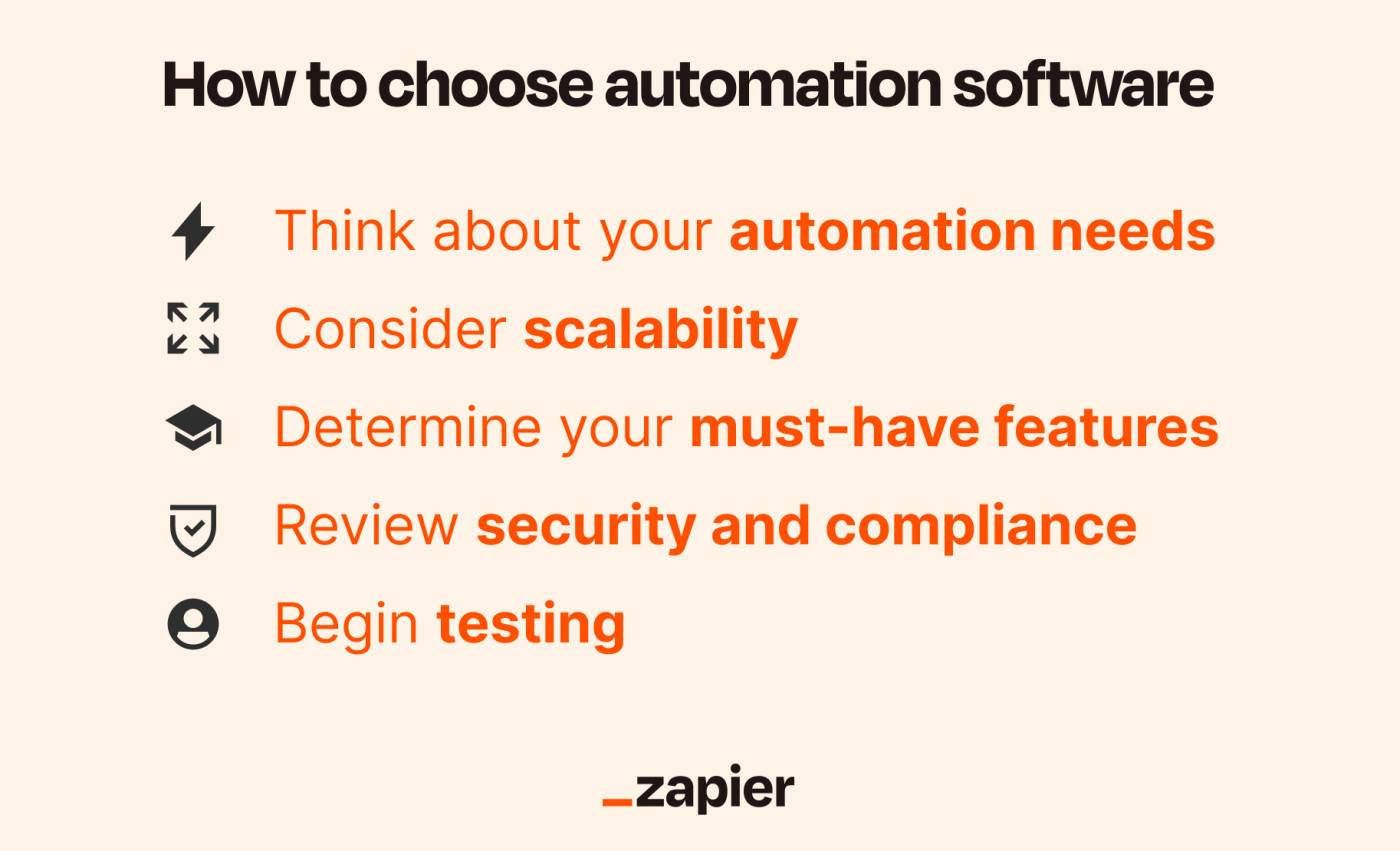You know automation is well worth the investment, and you're ready to use it to empower your teams, break down data silos, and make your business processes more efficient.
But signing up for any automation platform isn't going to transform your productivity overnight. You need to take some time to make sure you land on the best automation platform for your business.
You're reading this on the Zapier blog, and Zapier is an automation platform. Of course, we think we've built the best and easiest automation platform out there, but we still want to make sure you know what you're looking for, so you can feel confident in your choice.
Here are a few steps you can take when deciding if an automation platform is right for you.

1. Think about your automation needs
The best place to start is by thinking about what processes you want to automate. Wrapping your head around this first will help you understand your priorities when comparing tools.
Audit your current processes
To understand your automation needs, it helps to map out how your processes work right now and see where they're falling short. It could be out-of-date information in your customer relationship management (CRM) tool because of human error. Or it could be that only one or two IT workers manage processes for the entire organization, creating huge bottlenecks.
Imagine your ideal processes
Once you find the failing areas, think about how they would work in an ideal world. What if lead activity was automatically logged in your CRM as soon as it happened? Or if every team was empowered to build their own automated workflows?
Knowing how things work now and how you want them to work in the future will allow you to think through the best automation setup.
List the apps that are involved
Make a list of your tech stack and check each automation platform's app directory to ensure it integrates with your apps. Most platforms have all the most popular apps, but what team doesn't have a few niche tools in their tech stack?
Then, once you know that your current apps work with the platform's integrations, think about how your tech stack might expand in the future. Will the platform continue to support you?
Zapier, for example, integrates with more apps than any other automation platform (7,000 and growing!), so it's unlikely you'll add an app that won't work with Zapier. Even if you do, you can likely use webhooks to connect it.
Consider how complex your workflows will be
Consider the complexity of the workflows you want to automate. Does it mainly involve passing data directly from one app to another, or are multiple tools and steps involved? Most platforms can handle passing data back and forth, but if your workflows are complex, make sure you pick a platform that gives you the flexibility and customization you need.
Features like multi-step workflows, webhooks, advanced filtering, and logic—or even the ability to add custom code steps—are good indicators that an automation platform will be able to handle whatever you want to throw at it.
Estimate how many tasks you'll be automating
One figure you'll want handy is how many tasks—an action your workflow completes—you'll need to automate in a given month. This will factor into how much each platform will cost, as most platforms have pricing tiers based on how many tasks you use.
There's no way to get this perfectly right, but an estimate will help. For example, if you want to automatically add each lead that submits a form on your website to Salesforce, take a look at how many leads you've gathered month by month. That'll give you an idea of how many tasks you can expect to use from that specific workflow in a month.
2. Consider scalability
Software migrations are a headache—not to mention a significant strain on resources. When possible, it's best to avoid them. That's why, when selecting an automation platform, you'll want to choose one that can grow with you as you roll out automation more and more at your organization.
Here are some questions to ask:
Does this platform have features to help me spread automation across my organization (like SSO, advanced permissions, and activity monitoring)?
Will this platform get far more expensive the more I automate?
Can I upgrade or downgrade based on my needs if something changes?
Does the platform support enough apps that it will work with my tech stack long-term?
These questions will help you decide if a platform can grow with you as you automate more and more.
You should also look into what other products the platform offers. Is it just workflow automation, or can you take care of other business needs on it, too?
Zapier, for example, includes products for building chatbots (Zapier Chatbots), creating landing pages and forms (Zapier Interfaces), storing data (Zapier Tables), mapping out workflows (Zapier Canvas), and even working hand in hand with AI bots to run your entire business (Zapier Central).
If those kinds of extra features are important to you, be sure to check them out before committing.
3. Determine your must-have features
Aside from working with the apps you use, what other features will you need to make your workflows run smoothly?
Ease of use: A platform with an intuitive, drag-and-drop interface will likely be preferable for most of your team. Similarly, you want to be sure the tool is truly no-code, so everyone across the company can use it.
AI features: Platforms that help you capitalize on AI—either with AI integrations or by weaving it into their own products—will help set you up for success now and in the future. For example, Zapier integrates with plenty of AI tools, but it also has built-in AI tools, like an AI automation builder and copilot to help you along the way.
Built-in apps: Some platforms offer built-in apps that make automation easier (and sometimes cheaper). For example, Zapier offers built-in formatting, scheduling, and filtering apps, among many others—at no extra cost.
Security features: SSO, advanced admin permissions, and observability are just a few security features you should consider when selecting a platform.
Support: What's support like on each platform? Do they make it easy to troubleshoot and resolve your issues via AI assistants and help docs? And is there an excellent human support team to help resolve a problem when needed?
Depending on your needs, some of these features will be more important than others, so it's up to you to weigh which ones matter most.
4. Review security and compliance
Since automation involves moving sensitive data between platforms, it's especially important that an automation platform meets compliance and security standards.
Here are the questions to ask when vetting a platform's security standards:
Does it adhere to privacy standards specific to your area, like GDPR and CCPA?
Is it SOC-compliant?
Is there a dedicated security team?
Compliance with data protection standards, along with the security-first features I mentioned before, will go a long way in getting your platform approved by IT and keeping your information safe.
Read more about Zapier's enterprise-level compliance and security features here.
5. Begin testing
Once you understand how your processes work, where there are gaps, and the capabilities you'll need, it's time to start testing. Most platforms offer a free trial, allowing you to set up test workflows before committing to using it long-term. Carve out time to take full advantage of that trial period.
To start, you can keep tests simple—creating short, two-step workflows to get a feel for how things work. Before your trial is over, though, you'll want to stress-test each platform with something a little more complex to make sure it can handle the custom workflows you need to run. If you want to power your entire business with automation, it needs to be a powerhouse of a platform.
I'd also recommend inviting other users to test the tool as well. The goal here is to embrace automation across your entire company, so you want to make sure it's usable for your whole team.
Start automating today
If you're ready to start trying out automation platforms, you can contact our team or sign up for Zapier right now. You'll have two weeks to explore, build, tinker, and be sure it checks all your boxes. We think it will.
Related reading:






